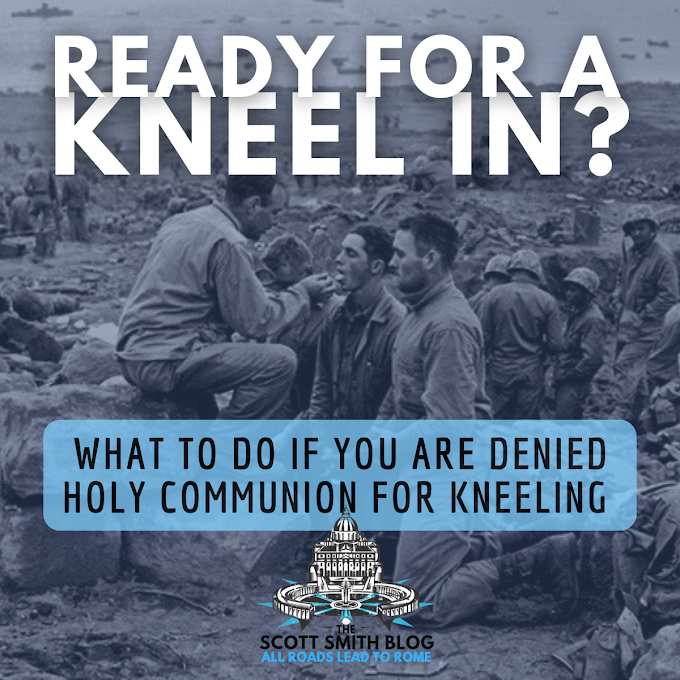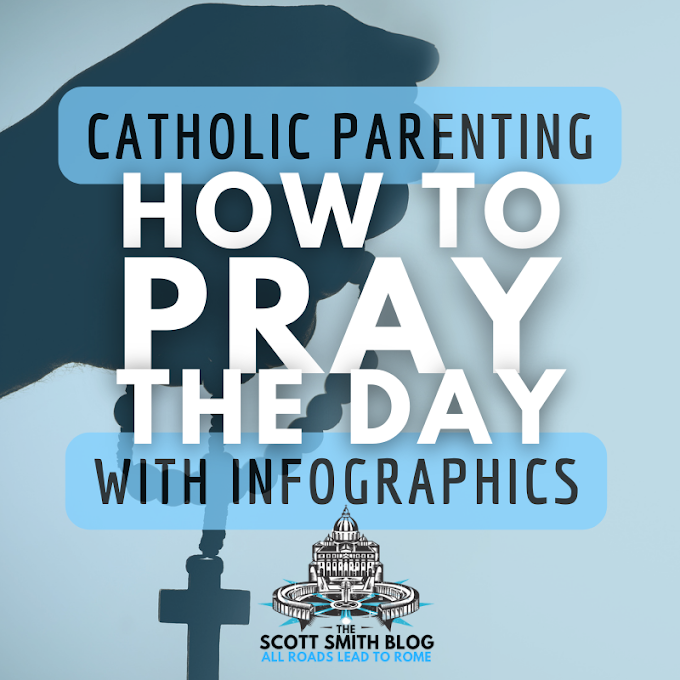It’s that time of year again! All the traditional sounds filling the cool night air: Autumn leaves crackling underfoot, the hum of children in costumes racing from house to house, and ... howls of Christian indignation over Halloween.[1]
Can traditional Catholics participate in this spookiest of holidays? Isn't it all just derived from devil worship?
First off, have you ever noticed the reference to Halloween in the Bible? This one is pretty spooky!
We'll also discuss how, yes, traditional Catholics can, with all respect to tradition, celebrate this traditionally Catholic celebration. Join in the discussion and don't forget to comment below!
Background on the Feasts of All Saints & All Souls
The word “Halloween” is a Scottish shortening of the phrase “All hallow-even,” literally meaning “All Holy Evening” and dates to the 18th century.The English have a similar phrase, “All Hallows’ Eve,” with the same meaning. These both describe the night before All Saints Day, November 1, and refer to the celebration of the holy men and women who are recognized in the Catholic Church as alive in Heaven. These men and women are collectively called the "Church Triumphant."
Though many claim that the celebration originated with the pagan rituals of Druids that escaped suppression by the Church, the origins of Halloween are very much Catholic.
The Catholic Church Created Halloween
Pope Gregory III established the feast during the 8th century after consecrating a chapel named in honor of “All Saints” in Saint Peter’s Basilica. This feast was originally celebrated on May 13th.
Later in the 840s, the feast was extended to the universal Church by Pope Gregory IV, making November 1st a holy day of obligation for all Catholics - this is how it spread to the British Isles. Along with its celebration, All Saints Day was given a special vigil Mass the night before, i.e. October 31, which led to that date being regarded by Catholics as a “holy evening.”
In 998, St. Odilo, the abbot of the powerful monastery of Cluny in southern France, added a celebration on November 2.[2] This was a day of prayer for the souls of all the faithful departed. This feast, called All Souls Day, spread from France to the rest of Europe.
Now, with feasts for those in Heaven and Purgatory, Irish Catholic peasants began to worry about the consequences of leaving out the souls damned to Hell. Though "All Damned Day" never became a Church feast for obvious reasons, it became customary to bang pots and pans on All Hallows Eve to let the damned know they were not forgotten.
For the Catholic origins of "Trick or Treat", check out the connection to Guy Fawkes day in this uCatholic article.
The First Halloween ... in the Bible?
Remember what happened immediately following Christ's death? Here's Matthew's account of the succeeding events (Matthew 27:51-53):And behold, the veil of the temple was torn in two, from top to bottom; and the earth shook, and the rocks were split; 52 the tombs also were opened, and many bodies of the saints who had fallen asleep were raised, 53 and coming out of the tombs after his resurrection they went into the holy city and appeared to many.
Isn't this an interesting passage? Scary! Most of these things re-occur, by the way, in the Book of Revelation, i.e. at the so-called "End Times". But what are we to make of it? Let's take note of a few things that are happening in this Gospel passage:
(1) The "Veil of the Temple" was Torn in Two from "Top to Bottom"
The "veil of the temple" was torn in two from "top to bottom". The veil of the temple, as it did in the Tabernacle of Moses, separated the Holy of Holies from the rest of the Temple and the rest of the world. When the veil was torn in two, the separation between the clean and unclean ended and the Temple was thereby desecrated.This is what Jesus prophesied at John 2 when he said "tear down this temple". The literal tearing down of the Temple occurred when the Jews tore down Jesus' body, i.e. the New Temple. The Temple was also destroyed, in a very real sense, at Christ's death by its desecration.
Note, also, it was torn from "top to bottom," which means this thick curtain was torn apart "from above."
(2) The "Rocks Were Split": Halloween & the Well of Souls
The "rocks were split" could be a reference to a spooky place called the "Well of Souls." This is the name of a cave located inside the Foundation Stone underneath the former site of the Temple in Jerusalem. The spooky title, the "Well of Souls", originates from a medieval Islamic legend and likely far more ancient writings that the spirits of the dead can be heard there, awaiting Judgment Day. |
| The Well of Souls cave |
The Gospel passage above talks about the raising of the bodies of the dead, right?
It is possible that the "rocks" which were split were those near the place where the veil was torn, i.e. the rocks or stones making up the walls and foundation of the Temple, itself.
Therefore, the mention of "rocks were split" could be a reference to the Foundation Stone. Were the Foundation Stone to split, it would release the purgatorial souls waiting beneath it in the "Well of Souls."
Note this, as well (we'll come back to this later): the Feast of All Souls, which follows Halloween and All Saints, is the feast for all those souls waiting in Purgatory - are you starting to see the connection?
(3) "Tombs opened", "Saints raised", "Coming out of tombs", and "Appeared to many"
If it weren't for the assurance of the evangelist Matthew that those rising from their tombs were "saints", wouldn't this seem an awful lot like a scene from a zombie movie? Bodies rising out of their graves and all that "Hocus Pocus"?What should be noted here is another reference to purgatorial souls, i.e. souls awaiting the Resurrection of their bodies. This is another possible connection to the "Well of Souls" and the splitting of the Foundation Stone.
What's more, it's another reference to the feast which accompanies Halloween and All Saints, the Feast of All Souls, meaning the souls waiting in Purgatory.
Pagan Origins of Halloween?
While largely debunked, many neo-pagans and pseudo-historians, such as those that proliferate on the History Channel, claim that Halloween originated with the pagan Celtic celebration of Samhain. In his book Stations of the Sun, historian Ronald Hutton explains:[3][4]
[T]he medieval records furnish no evidence that 1 November was a major pan-Celtic festival, and none of religious ceremonies, even where it was observed (p. 362).
This idea largely originated with the Protestants, who wanted to distance themselves from, not only Catholic holidays and traditions, but specifically Purgatory and prayers for the dead. Disconnecting Halloween from its Christian origins while fabricating a pagan origin served to de-legitimize the feast days of All Saints and All Souls.
Back to Samhain for One Last Spooky Connection ...
Not to delve too deep into pagan mythology, but Samhain was seen as a liminal time. During such a time, the boundary between this world and the spirit world could more easily be crossed. That is, the veil of this world and the next was at its thinnest.Think for a moment, didn't a veil come up earlier in this discussion? The time in Scripture when the boundary between this world and the Netherworld was being crossed by saints rising from their tombs corresponded with what other event? The tearing of the veil of the Temple! The veil of the Temple was the earthly representation of the boundary between earth and Heaven, as well.
Best not to read too much into this odd coincidence between two ancient religions! But it's interesting and a little spooky, nonetheless.
This Halloween, Check out my Pro-Life Catholic Horror Novel, The Seventh Word
My own contribution to the Catholic spookiness of Halloween ... my Pro-Life Catholic Horror novel: The Seventh Word ...Here's the premise. The Aztecs sacrificed their children to one of their gods. What if he decided to open up an abortion clinic?
I hope you enjoyed this article. Please remembers to share it with your friends and comment below! Happy Halloween! All Saints, pray for us!
Footnotes:
[1] I have to admit I borrowed from some of Jimmy Aiken's delightful prose found in this other good article on the holiday, "Reinventing the Halloween Light."[2] For more on this, check out this uCatholic article.
[3] For more on debunking the Samhain-Halloween connection, here's a great article from Catholic Answers.
[4] The jack-o’-lantern idea was thrown in as another half-baked basis for the druid origin. Lamps made from turnips (not pumpkins) had been part of ancient Celtic harvest festivals, so they were translated to the American Halloween celebration.















0 Comments